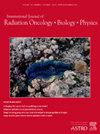Neoadjuvant Chemoradiation (CROSS) vs. Perioperative Chemotherapy (FLOT) in Esophageal Adenocarcinoma (EAC): ESOPEC – a Randomised Controlled Prospective Multicentre Phase III Trial
IF 6.4
1区 医学
Q1 ONCOLOGY
International Journal of Radiation Oncology Biology Physics
Pub Date : 2024-10-01
DOI:10.1016/j.ijrobp.2024.08.020
引用次数: 0
Abstract
Purpose/Objective(s)
When designing the ESOPEC trial, the CROSS (C) regimen provided the highest level of evidence of neoadjuvant therapy for both, squamous cell (ESCC) and EAC. During recruitment into ESOPEC, the FLOT(F)-4 trial identified perioperative 5-fluorouracil, leucovorin (L), oxaliplatin (O) and docetaxel (T) as best evidence of chemotherapy. The ESOPEC trial aimed to compare the two protocols exclusively in EAC and hypothesized F to be superior to C.
Materials/Methods
Included were patients with cM0 EAC staged cT1 N+ or cT2-4a, cN0/+. C was the control arm with 41.4 Gy in 23 fractions and 5 weekly simultaneous doses of carboplatin (2 mg/ml/min AUC) and paclitaxel [(50 mg/m²); CP]. GTV and PTV were defined as described by Matzinger et al. (doi: 10.1016/j.radonc.2009.03.018). F was the experimental arm with 5-fluorouracil 2600 mg/m² (24 hours), d1 L 200 mg/m², d1 O 85 mg/m², d1 T 50mg/m2, d1 every two weeks (q2w); 4 neoadjuvant cycles (8 weeks) prior to surgery and 4 adjuvant cycles (8 weeks) postoperatively. Esophagectomy was done 4-6 weeks after neoadjuvant therapies. Primary endpoint was overall survival (OS), secondary endpoints were progression free survival (PFS), ypTNM stage, tumor regression grading, recurrence free survival (RFS) in patients with R0/R1 resection, site of tumor recurrence, postoperative complications, adverse events, and quality of life. Sample size calculation was based on 1-sided significance level of 2.5% and 90% power assuming a hazard ratio (HR) of 0.645 with respect to OS, and required 218 death events (438 patients). Prospectively documented chemoradiotherapy specific variables consisted in administered percentage of planned chemo- and radiotherapy, adherence to target volume definitions, doses to organs at risk, specifically heart and lungs.
Results
From 2/16 to 4/20, 438 patients were randomized to C (217) and F (221), intention-to-treat population (ITT). Characteristics were well balanced with mean age of 63 years, 89.3% males, 73.9% cT3, 6.7% cT4, 79.7% cN+. Neoadjuvant treatment was started in 90.3% (196) vs 93.7% (207) in C vs F (per-protocol-population (PP)). In PP, full RT dose was given in 98.0% (192); 75.0% (147), 18.9% (37) and 6.1% (12) had 5, 4 or <4 cycles of CP. In ITT, surgery rates were C 82.9% (180) vs F 86.4% (191). In 371 patients with surgery, local pCR rates were 13.3% (C) vs 18.3% (F), and near CR rates 39.4% (C) vs 25.1% (F). In 368 patients with R0/R1 resection, 3-year RFS after surgery was 36.5% (C) and 52.8% (F), median RFS was 17 (C) vs 43 (F) months (HR 0.68 [0.51 – 0.90]; p = 0.0076). Postoperative morbidity was comparable. In ITT, 3-year-OS was 50.7% (C) and 57.4% (F), and median OS was 37 (C) vs 66 (F) months (HR 0.70 [0.53 – 0.92]; p = 0.012).
Conclusion
Both C and F were well tolerated. OS was superior after F vs C, and F should be preferred over C. Posthoc limitations of C were: baseline FDG-PET/CT not mandatory and absence of additive immunotherapy.
食管腺癌 (EAC) 的新辅助化疗 (CROSS) 与围手术期化疗 (FLOT):ESOPEC - 一项随机对照前瞻性多中心 III 期试验
目的/目标在设计 ESOPEC 试验时,CROSS (C) 方案为鳞状细胞 (ESCC) 和 EAC 的新辅助治疗提供了最高水平的证据。在 ESOPEC 的招募过程中,FLOT(F)-4 试验确定围手术期 5-氟尿嘧啶、亮氨醇 (L)、奥沙利铂 (O) 和多西他赛 (T) 为最佳化疗证据。ESOPEC试验旨在比较这两种方案对EAC的治疗效果,并假设F优于C.材料/方法包括分期为cT1 N+或cT2-4a、cN0/+的cM0 EAC患者。C为对照组,剂量为41.4 Gy,分23次进行,每周同时使用5次卡铂(2 mg/ml/min AUC)和紫杉醇[(50 mg/m²);CP]。GTV和PTV的定义如Matzinger等人(doi: 10.1016/j.radonc.2009.03.018)所述。F为实验组,5-氟尿嘧啶2600毫克/平方米(24小时),d1 L 200毫克/平方米,d1 O 85毫克/平方米,d1 T 50毫克/平方米,d1每两周一次(q2w);术前4个新辅助周期(8周),术后4个辅助周期(8周)。食管切除术在新辅助疗法后4-6周进行。主要终点是总生存期(OS),次要终点是无进展生存期(PFS)、ypTNM分期、肿瘤消退分级、R0/R1切除患者的无复发生存期(RFS)、肿瘤复发部位、术后并发症、不良事件和生活质量。样本量的计算基于2.5%的单侧显著性水平和90%的功率,假设OS的危险比(HR)为0.645,且需要218例死亡事件(438例患者)。结果从2/16到4/20,438名患者被随机分配到C组(217人)和F组(221人),意向治疗人群(ITT)。患者特征非常均衡,平均年龄为63岁,89.3%为男性,73.9%为cT3,6.7%为cT4,79.7%为cN+。C组与F组(按方案人群(PP))中,90.3%(196人)与93.7%(207人)开始了新辅助治疗。在 PP 组中,98.0%(192 例)接受了全 RT 剂量治疗;75.0%(147 例)、18.9%(37 例)和 6.1%(12 例)接受了 5、4 或 4 个周期的 CP 治疗。在 ITT 中,手术率为 C 82.9% (180) vs F 86.4% (191)。在371例手术患者中,局部pCR率为13.3%(C)vs 18.3%(F),近CR率为39.4%(C)vs 25.1%(F)。在368名接受R0/R1切除术的患者中,术后3年RFS分别为36.5%(C)和52.8%(F),中位RFS分别为17个月(C)和43个月(F)(HR 0.68 [0.51 - 0.90];P = 0.0076)。术后发病率相当。在 ITT 中,3 年 OS 为 50.7%(C)和 57.4%(F),中位 OS 为 37(C)个月 vs 66(F)个月(HR 0.70 [0.53 - 0.92];P = 0.012)。F 与 C 相比,OS 更优,应首选 F,而不是 C。C 的事后限制是:基线 FDG-PET/CT 不是强制性的,而且没有附加免疫疗法。
本文章由计算机程序翻译,如有差异,请以英文原文为准。
求助全文
约1分钟内获得全文
求助全文
来源期刊
CiteScore
11.00
自引率
7.10%
发文量
2538
审稿时长
6.6 weeks
期刊介绍:
International Journal of Radiation Oncology • Biology • Physics (IJROBP), known in the field as the Red Journal, publishes original laboratory and clinical investigations related to radiation oncology, radiation biology, medical physics, and both education and health policy as it relates to the field.
This journal has a particular interest in original contributions of the following types: prospective clinical trials, outcomes research, and large database interrogation. In addition, it seeks reports of high-impact innovations in single or combined modality treatment, tumor sensitization, normal tissue protection (including both precision avoidance and pharmacologic means), brachytherapy, particle irradiation, and cancer imaging. Technical advances related to dosimetry and conformal radiation treatment planning are of interest, as are basic science studies investigating tumor physiology and the molecular biology underlying cancer and normal tissue radiation response.

 求助内容:
求助内容: 应助结果提醒方式:
应助结果提醒方式:


